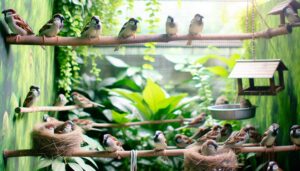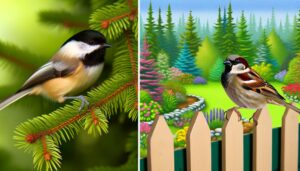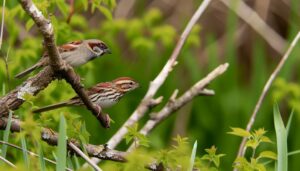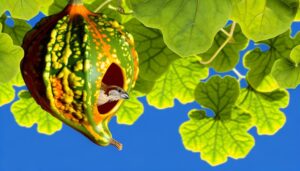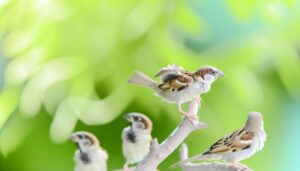House Wren Vs House Sparrow – Key Differences Explained
House Wrens (Troglodytes aedon) are compact birds marked by brownish-grey plumage and a long, slightly curved bill, adapted for insect foraging. In contrast, House Sparrows (Passer domesticus) are larger, with males featuring a distinctive black bib and a conical bill suited for seed consumption.
The melodious songs of House Wrens differ significantly from the repetitive chirps of House Sparrows. Nesting habits also vary; House Wrens use natural cavities and are territorial, while House Sparrows prefer urban environments and exhibit colonial nesting behaviors.
Their dietary preferences and interspecific competition, particularly over nesting sites, offer intriguing ecological dynamics worth exploring further.
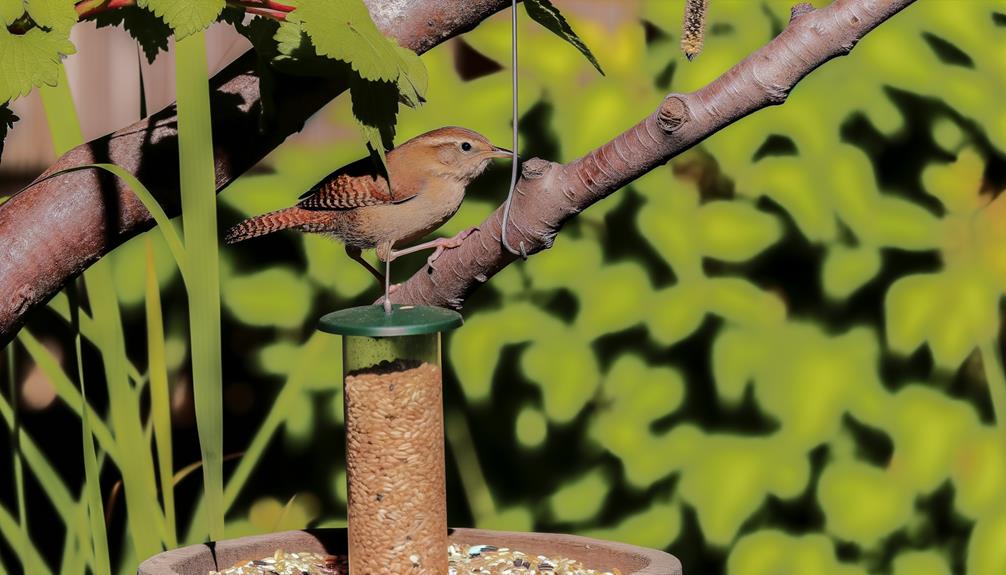
Key Takeaways
- House Wrens have a compact body and melodious trills, while House Sparrows are robust with repetitive chirps.
- House Sparrows often displace House Wrens from nesting sites, leading to conflicts.
- House Wrens are insectivorous, aiding in pest control, whereas House Sparrows primarily consume seeds and grains.
- House Wrens nest in concealed cavities, while House Sparrows prefer urban crevices and exhibit colonial nesting.
- House Sparrows adapt well to human environments, impacting House Wren populations through competition for resources.
Physical Characteristics
How do the physical characteristics of the House Wren (Troglodytes aedon) and the House Sparrow (Passer domesticus) differentiate these two avian species regarding morphology and plumage?
The House Wren exhibits a compact body, approximately 11-13 cm in length, with a subtle brownish-grey plumage adorned with fine barring. It has a relatively long, slightly curved bill suited for insect foraging.
Conversely, the House Sparrow is more robust, measuring around 14-18 cm. Males display a distinctive black bib, white cheeks, and chestnut nape, while females and juveniles exhibit more subdued brown and grey tones. The House Sparrow's conical bill is adapted for seed consumption.
Such morphological and plumage distinctions reflect their differing ecological niches and behavioral adaptations.
Songs and Calls
The vocalizations of the House Wren (Troglodytes aedon) are characterized by a melodious and complex series of trills and bubbling notes, which serve both territorial and mating purposes. Research indicates that male House Wrens produce a repertoire of 12 to 16 song types to attract females and defend their territory.
In contrast, the House Sparrow (Passer domesticus) exhibits a simpler vocal pattern. Its song consists of repetitive chirps and cheeps, lacking the intricate structure found in House Wrens. Studies have shown that House Sparrow males use these calls mainly for social bonding and territory establishment.
The distinct vocal differences between these species highlight their divergent evolutionary paths and ecological niches.
Nesting Behaviors
Exhibiting distinct nesting behaviors, House Wrens (Troglodytes aedon) generally prefer to construct their nests in natural cavities or artificial nest boxes, utilizing twigs, grasses, and feathers to build a well-insulated structure. Their nesting sites are often selected based on strategic concealment and protection from predators.
In contrast, House Sparrows (Passer domesticus) are more opportunistic, frequently nesting in urban environments, including building crevices and vents. They exhibit a propensity for reusing nests, often incorporating materials like paper, string, and other urban detritus. Research indicates that House Sparrows display a colonial nesting behavior, often nesting in proximity to other conspecifics.
This behavioral divergence in nesting site selection and material usage reflects adaptations to their respective ecological niches.
Diet and Feeding
Both House Wrens and House Sparrows exhibit distinct dietary preferences and feeding behaviors, shaped substantially by their respective habitats and ecological requirements. House Wrens primarily consume insects and arachnids, capitalizing on their insectivorous nature to forage in dense vegetation. Research indicates that they often target beetles, caterpillars, and spiders, providing ecological pest control.
Conversely, House Sparrows are mainly granivorous, supplementing their diet with seeds, grains, and occasional insects. Studies have shown that their foraging occurs in open areas, often near human habitation, where food resources are abundant. These dietary distinctions underscore their adaptive strategies: House Wrens optimize insect availability in natural habitats, while House Sparrows exploit human-altered environments for sustenance.
Interactions and Conflicts
Interactions between House Wrens and House Sparrows frequently result in competitive conflicts, particularly over nesting sites and territory. These avian confrontations are well-documented and stem from overlapping ecological niches. House Sparrows, with their aggressive demeanor, often displace House Wrens from preferred nesting cavities. Research indicates that such encounters can lead to significant impacts on House Wren populations.
Key competitive behaviors observed include:
- Nest usurpation: House Sparrows forcibly take over House Wren nests, often destroying eggs or nestlings.
- Territorial disputes: Both species engage in vocal and physical displays to assert dominance over prime nesting locations.
- Resource competition: Both species vie for similar food sources, exacerbating interspecific tension.
Understanding these interactions is vital for avian conservation efforts.
Conclusion
In the intricate tapestry of avian life, the house wren and house sparrow emerge as distinct threads, each with unique physical characteristics, vocalizations, nesting behaviors, and dietary preferences.
While the house wren captivates with melodious calls and meticulous nesting, the house sparrow asserts dominance through adaptability and resourcefulness.
Their interactions, often marked by competition, underscore the complex dynamics of coexistence.
Through detailed observation and research, the nuanced differences between these species illuminate broader ecological patterns.

